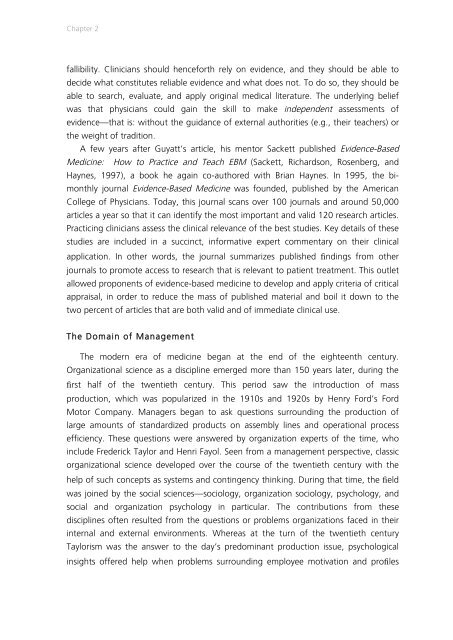In Search of Evidence
jqluvth
jqluvth
Create successful ePaper yourself
Turn your PDF publications into a flip-book with our unique Google optimized e-Paper software.
Chapter 2<br />
fallibility. Clinicians should henceforth rely on evidence, and they should be able to<br />
decide what constitutes reliable evidence and what does not. To do so, they should be<br />
able to search, evaluate, and apply original medical literature. The underlying belief<br />
was that physicians could gain the skill to make independent assessments <strong>of</strong><br />
evidence–that is: without the guidance <strong>of</strong> external authorities (e.g., their teachers) or<br />
the weight <strong>of</strong> tradition.<br />
A few years after Guyatt’s article, his mentor Sackett published <strong>Evidence</strong>-Based<br />
Medicine: How to Practice and Teach EBM (Sackett, Richardson, Rosenberg, and<br />
Haynes, 1997), a book he again co-authored with Brian Haynes. <strong>In</strong> 1995, the bimonthly<br />
journal <strong>Evidence</strong>-Based Medicine was founded, published by the American<br />
College <strong>of</strong> Physicians. Today, this journal scans over 100 journals and around 50,000<br />
articles a year so that it can identify the most important and valid 120 research articles.<br />
Practicing clinicians assess the clinical relevance <strong>of</strong> the best studies. Key details <strong>of</strong> these<br />
studies are included in a succinct, informative expert commentary on their clinical<br />
application. <strong>In</strong> other words, the journal summarizes published findings from other<br />
journals to promote access to research that is relevant to patient treatment. This outlet<br />
allowed proponents <strong>of</strong> evidence-based medicine to develop and apply criteria <strong>of</strong> critical<br />
appraisal, in order to reduce the mass <strong>of</strong> published material and boil it down to the<br />
two percent <strong>of</strong> articles that are both valid and <strong>of</strong> immediate clinical use.<br />
The Domain <strong>of</strong> Management<br />
The modern era <strong>of</strong> medicine began at the end <strong>of</strong> the eighteenth century.<br />
Organizational science as a discipline emerged more than 150 years later, during the<br />
first half <strong>of</strong> the twentieth century. This period saw the introduction <strong>of</strong> mass<br />
production, which was popularized in the 1910s and 1920s by Henry Ford’s Ford<br />
Motor Company. Managers began to ask questions surrounding the production <strong>of</strong><br />
large amounts <strong>of</strong> standardized products on assembly lines and operational process<br />
efficiency. These questions were answered by organization experts <strong>of</strong> the time, who<br />
include Frederick Taylor and Henri Fayol. Seen from a management perspective, classic<br />
organizational science developed over the course <strong>of</strong> the twentieth century with the<br />
help <strong>of</strong> such concepts as systems and contingency thinking. During that time, the field<br />
was joined by the social sciences–sociology, organization sociology, psychology, and<br />
social and organization psychology in particular. The contributions from these<br />
disciplines <strong>of</strong>ten resulted from the questions or problems organizations faced in their<br />
internal and external environments. Whereas at the turn <strong>of</strong> the twentieth century<br />
Taylorism was the answer to the day’s predominant production issue, psychological<br />
insights <strong>of</strong>fered help when problems surrounding employee motivation and pr<strong>of</strong>iles


